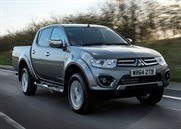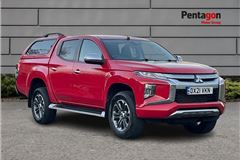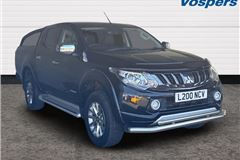Mitsubishi L200 (2006 – 2015) Review
Mitsubishi L200 (2006 – 2015) At A Glance
The Mitsubishi L200 arrived in 2006 riding high on the success of its rough and tough predecessor. With more rounded looks and greater refinement, this L200 is a considerable step on from the model that made it a familiar name beyond building sites. It was one of the first among this generation of pick-ups to embrace a bit of glitz and glamour in its style. It helps the L200 disguise its working class roots to be an equal among many SUVs.
There’s a choice of 134PS or 175PS 2.5-litre turbodiesel engines that comes with a healthy dollop of low and mid-rev grunt. It helps the L200 to be nippy on the road and very capable when it steers on to rougher ground. However it's not especially refined on road, especially compared to other pick ups like the Volkswagen Amarok, and the suspension errs on the workmanlike side of acceptable.
Single, Club and Double Cab models are offered, catering for the purely utilitarian market and those seeking something with more rounded talents. Mitsubishi also offers its Warrior and Barbarian models that add a big dose of attitude and equipment. The Double Cab is the most popular and you can fit five people in at a squeeze.
Driving the Mitsubishi L200 (2006 – 2015)
The Mitsubishi L200 does its best to tread a middle path between the rugged ability required by a pick-up that can lug a payload of up to 1050kg and the need for on-road comfort. Unfortunately, duty comes before pleasure with the L200 and its suspension errs on the workmanlike side of acceptable. This means a ride that bounces noticeably over any road that is not milled smooth. A saving grace is the suspension is quite soft set so it doesn’t jar in the way a Toyota Hilux’s does when the L200 encounters the many potholes and scars of the UK’s roads.
There’s no getting away from that bounce, however, when the L200 doesn’t have much in the load bed. It also means the rear wheels can spin up all too easily coming out of junctions or slow corners as the tyres scrabble with the job of transmitting the power to the road. Switch into four-wheel drive mode and this problem disappears, but economy will suffer if you leave the L200 in all-wheel drive all of the time.
Off-road, the L200 is impressive and can easily mix with the best in this class. A Land Rover Defender will go further into the countryside than the Mitsubishi, but you’d much rather be at the wheel of the L200 when you get back on mettled roads.
The two engine options in the L200 and both are sound propositions. For the saving in buying and running costs, we’d steer towards the 134PS 2.5-litre turbodiesel as this four-cylinder engine is more than capable of lugging the 1865kg L200 from pillar to post. It offers a nifty turn of speed when asked to work harder, which it does with willing ease. It also does this with a fair degree of noise from under the bonnet, so it’s better to get the L200 to cruising speed as promptly as possible and then let the hefty mid-range shove do the work.
The 175PS diesel offers more of the same, so it’s quicker and brawnier, making even lighter work of towing a trailer or ascending steep slopes in a field. However, it also shares its less powerful sibling’s penchant for making itself heard unless you’re cruising, and even then both engines emit a constant background drone. Road noise, at least, is sealed out very effectively from the L200’s cabin, but wind noise is another unwelcome companion at higher speeds.
Regardless of what speed you’re travelling at, the L200’s steering is always a little too vague for our liking. Compared to a Ford Ranger or Isuzu D-Max, the L200’s helm tells you almost nothing of what is going on at the front wheels. While this means there are no nasty shocks sent through the wheel when off-roading, it also makes the Mitsubishi harder to place as you enter a corner or roundabout. It is light and east when parking, but this shouldn’t mean foregoing all sensation on the open road.
Mitsubishi L200 (2006 – 2015) interior
There’s no hiding the L200’s usefulness now that Mitsubishi has addressed the problem of the load bed being too short in the earlier models. By offering a Long Bed version, users can now fit items up to 2220mm in length into the load bed and still shut the tailgate. If you go for the Double Can model, you’ll have to accept a shorter load bed that cuts usable length down to 1505mm. The Club Cab offers a compromise of 1805mm of length in the load bed.
A fold-down tailgate can be set to sit flush with the load bed or it can drop down further to give better access to the load area. This is especially useful when loading and unloading heavier items. Given the L200 can carry up to 1120kg of cargo, depending on the model you choose, the ability to get at the load without bending your spine too much is very handy. The L200 can also tow up to 2700kg with a braked trailer, so it matches most rivals and betters the Toyota Hilux’s 2500kg limit. Still, a Land Rover Defender will haul up to 3500kg, so the Mitsubishi doesn’t own bragging rights here.
In the Club Cab, there is some additional storage behind the two front seats for bags or tools, which means they are more secure than rattling around the load bed. The tailgate can be locked separately and Mitsubishi offers a roller cover for the load area, as well as hardtops for the Double Cab models.
The Double Cab is a popular choice in the L200 range as it can seat five in reasonable comfort. Whoever has to sit in the middle seat in the back, however, will need to be short in the leg measurement as knee room is limited. Also, the middle seat offers noticeably less padding and comfort. With the two outer rear seats, though, comfort is good and the raised bench gives a good view out over the front seats.
More storage would be welcome in the rear of the Double Cab’s cabin as there’s nowhere to store a larger bottle of water or the other gubbins that tends to accompany modern life. In the front of the cabin, there are more storage options and the driver has a high set seat that gives a commanding view forward. The styling of the L200, with its upswept window line and thick rear pillars, however, means over the shoulder vision for the driver is not great when changing lane or backing into a tight space.
Finding the right seating position is simple for the driver thanks to height adjustment for the seat and steering wheel, but all-day comfort is compromised by the seat base being too short. It results in the driver missing support under his thighs and fidgeting sets in on longer journeys.
We like the simple controls for the main functions on the L200 and the snazzy dials of the instrument binnacle, but the stereo requires a NASA technician to fathom it and then you’ll need the aid of someone with very thin fingers to prod the tiny buttons. Still, Mitsubishi doesn’t stint when it comes to the amount of kit it puts in the L200 compared to rivals, especially when you move up to the Warrior and Barbarian models.
Mitsubishi L200 (2006 – 2015) models and specs
| Dimensions | |
|---|---|
| Length | 4295–5185 mm |
| Width | 1750–1815 mm |
| Height | 1615–1780 mm |
| Load Volume | 1.2 m3 |
| Miscellaneous | |
|---|---|
| Kerb Weight | 1525–1900 kg |
| Payload | 535–1120 kg |
| Warranty | 60/125,000 |
| Servicing | 9000 |
4X4 Van
| Version | List Price | MPG | |
|---|---|---|---|
| 1.8 Diesel 4Work 4WD | £18,208 | 49.6 mpg | Details |
Club Cab
| Version | List Price | MPG | |
|---|---|---|---|
| Club Cab 2.5 DI-D 4Life | £16,959 | 36.7 mpg | Details |
| Club Cab 2.5 DI-D 4Work | £15,459 | 36.7 mpg | Details |
Double Cab
Single Cab
| Version | List Price | MPG | |
|---|---|---|---|
| Single Cab 2.5 DI-D 4Life | £15,845 | 37.7 mpg | Details |
| Single Cab 2.5 DI-D 4Work | £14,499 | 37.7 mpg | Details |
Model History
- December 2005: Pricing announced for new L200
- April 2006
- October 2006: L200 Club Cab and the Single Cab Tipper launched
- August 2007: Raging Bull Limited Edition launched
- March 2008: Awarded four star Euro NCAP rating
- January 2009: L200 Trojan launched
- April 2010: L200 Trojan Double Cab launched
- May 2012: L200 Barbarian Black model introduced
- October 2012
- November 2012
- January 2015: L200 Challenger launched
December 2005
Pricing announced for new L200
The model line-up and pricing for the new L200 pick-up were announced by Mitsubishi. In showrooms from the end of February 2006, many prices were reduced from the outgoing range with prices starting at £12,249 CVOTR for the 4Work 4WD single cab rising to £19,999 CVOTR for the new range-topping double cab Elegance.
April 2006
Strong residual values predicted. Motor industry barometers CAP Monitor and EurotaxGlass’s hailed Mitsubishi’s new L200 pick-up as the clear segment leader for predicted residual values. The April edition of CAP Monitor confirmed that after three years and 60,000 miles the new L200 Warrior will retain around 48 per cent of its original value. As an example, the Warrior automatic priced at £17,799 CVOTR is expected to be worth £8,150 after three years.
October 2006
L200 Club Cab and the Single Cab Tipper launched
With four body-styles launched and a wide range of specifications available to suit all business needs, Mitsubishi now boasted one of the most comprehensive range of pick-ups on the market.
The Club Cab’s two-door with rear bench seat configuration provides the flexibility of either being able to carry four adults or providing additional space for secure stowage of tools and equipment. It also boasts a load bed 1.8 m long – 48 cm longer than that of the double cab. Available in 4Work, 4Life and Warrior variations, all Club Cabs feature a 2.5-litre turbo-diesel engine and come with easy-select four-wheel-drive plus rear diff-lock across the range.
The L200 Tipper has been created in conjunction with one of the UK’s most respected conversion companies, Southampton-based VFS. The flat 2405 x 1650 cm tipper bed is supported by a powder-coated sub-frame and surrounded by aluminium side and tail boards with six load-lashing points. The conversion also includes thermoplastic mudguards and a tubular rear-cab protector with infill panels and ladder stops, plus locking toolboxes located either side of the sub-frame.
August 2007
Raging Bull Limited Edition launched
Badged the L200 Raging Bull to tie in with Vickery’s exclusive performance clothing company, the new model comes with £2,000 worth of extras for free. Only available in vibrant Aztec Red and as a Double Cab vehicle, the L200 Raging Bull includes a number of unique features. Most obvious is the dramatic Raging Bull motif at the base of the driver and passenger doors. It’s also stitched into the back support of the leather front seats, and stamped into the front door entry guards.
March 2008
Awarded four star Euro NCAP rating
Impressive four star rating was ahead of the competition like the Ford Ranger with two stars and the Isuzu Rodeo with just one star.
January 2009
L200 Trojan launched
Like the previous generation, the new L200 Trojan is positioned to sit just below the L200 Warrior, with a competitive price-point and standard equipment including 16-inch alloy wheels, super select 4WD, a trip computer, rear electric windows, colour coded wheelarch extensions, chrome door handles, a rear differential lock. CD stereo, climate control, privacy glass, a Cat 1 alarm and chrome heated folding electric mirrors.
The L200 Trojan will be available in Aztec Red (solid), Cosmos Black (metallic), Sapphire Blue (metallic) and Starlight Silver (metallic) costing £350 plus VAT.
April 2010
L200 Trojan Double Cab launched
The L200 Trojan will only be available with Mitsubishi’s ‘standard bed’ option and is positioned to sit just below the L200 Warrior in specification and pricing, while offering exceptional value for money. The vehicle will feature the following high level of standard equipment: Euro IV 2.5 DI-D common rail turbodiesel engine, 16-inch alloy wheels, rear differential lock, super select 4WD, CD stereo, trip computer, climate control, rear electric window, chrome electric door mirrors with heater/folding function, colour coded wheel arch extensions, privacy glass, chrome outer door handles and a Cat 1 alarm.
May 2012
L200 Barbarian Black model introduced
It gets added stylish accessories in the form of a black satin roof, sports grille, resin guard, wing mirrors and door handles, plus the fuel filler cap, light bezels, rear bar and side steps all transform the L200 Barbarian. This is all finished off with black 17-inch alloy wheels and all new carbon effect leather seats. Available in both manual and automatic derivatives, the L200 Barbarian Black features an impressive range of additional equipment to the standard Mitsubishi L200 Barbarian.
October 2012
Mitsubishi Motors announced that the Mitsubishi L200 now comes with the longest warranty of any pick-up truck in the UK marketplace, providing customers with peace of mind for a class-leading five years/125,000 miles.
November 2012
Rated by Warranty Direct as the Most Reliable Car of the past 15 years based on Warranty Direct claims statistics.
January 2015
L200 Challenger launched
The new addition priced from £16,499 and comes witha 175bhp engine, Super Select 4WD system, 17-inch alloy wheels, cruise control, climate control air conditioning, automatic rain & dusk sensors, privacy glass, Bluetooth, plus a leather steering wheel and gear lever.

.jpg?width=640&height=426&rmode=crop)
.jpg?width=640&height=426&rmode=crop)
.jpg?width=640&height=426&rmode=crop)
.jpg?width=640&height=426&rmode=crop)
.jpg?width=640&height=426&rmode=crop)
.jpg?width=640&height=426&rmode=crop)


 Extremely tough running gear, long tyre life, durable interior, proven four-wheel drive system.
Extremely tough running gear, long tyre life, durable interior, proven four-wheel drive system.
 Small load bed on double cab but overcome with long bed version, 2.5 DI-D still belt cam.
Small load bed on double cab but overcome with long bed version, 2.5 DI-D still belt cam.



